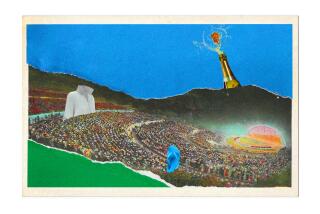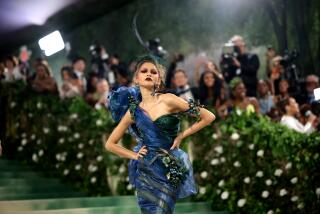Black-tie traditions loosen up
No hems grazed the red carpet when actresses Kate Capshaw and Rita Wilson swept into a black-tie gala in Beverly Hills.
Far from it. Instead of the gowns usually seen at such affairs, the women -- wives of producer-director Steven Spielberg and actor Tom Hanks, respectively -- wore slim, tailored pants with informal tops, Capshaw not even wearing a jacket over the black sleeveless T-shirt she paired with beaded Gucci trousers. And neither bow ties nor cummerbunds were worn by their husbands. Instead, the men chose elegantly cut black suits, Spielberg combining his with a white shirt and long black silk tie, Hanks with a handsome black shirt, open at the neck.
Once considered the sine qua non of evening silhouettes, the black-tie tradition is being loosened in the name of ease and self-expression. As Hanks said when he thanked guests for attending the recent event: “Bet you’re so sick of getting dressed in tuxedos and high heels.”
Even the popular “cocktail attire” code is being taken less seriously, with guests frequently arriving at chic receptions in street clothes. Only the “California casual” option, seen mostly at private parties, is maintaining its status quo -- as in the requisite jeans with designer shirts and jackets and easy-on-the-jewelry.
Blame the laid-back trend on rebels such as actor Brad Pitt, says a fashionable Manhattanite retailer who also attended the fund-raiser at the Beverly Hilton Hotel. “During the past few years, we’ve seen actors like Pitt showing up at formal events in open-collared shirts, and that’s trickling down. We all want to look like Brad Pitt.”
Hollywood fashion guru Phillip Bloch, stylist to such best-dressed stars as Halle Berry and Jim Carrey, explains the phenomenon this way: “I don’t think there is a dress code that anyone strictly follows anymore. But I think that everyone in Hollywood likes to be, if not politically, then ‘partying’ correct. And that means that if an event is black tie, you can go very formal if you want, but it’s not absolutely required. Codes have become less of a mandate and more for setting a mood.”
Even biting fashion critic Mr. Blackwell approves of the dressing down he’s seeing at high-profile events. The simpler silhouettes are “revolutions against a boring tradition,” he says. “It was just becoming a little too much seeing all of these armies of penguins. There’s a new sense of what’s right and what’s wrong now. Less was always more. We have to begin to see things differently, let go.”
But the easing of formality began long before Hollywood iconoclasts came on the scene, says fashion historian Valerie Steele,director of the Museum at the Fashion Institute of Technology in New York. Ironically, black tie, a dress code that gained popularity in the late 19th century, started out as a “low-key, informal version of formal dress, which was white tie,” Steele explains. “Men’s clothes have been becoming less formal for more than a century, and it’s going to continue, because the lifestyle that supported a formal way of dressing has disappeared. It’s a much more democratic climate now, when people are concerned with issues like comfort and expressing their personality and not so much concerned with issues of obvious social status.”
In Bloch’s hip scheme of things, black tie for men now means single-button black suits worn with long black ties or open-collared shirts -- even when they’re tuxedo shirts. Men who insist on wearing a traditional tux with a bow tie and cummerbund send an “I’m a classic kind of guy who’s afraid to advance” message, he adds.
For women, black tie can mean a short or long dress, a tux-style pantsuit or evening separates -- such as a beaded top with pants, says Kari Miller, a spokeswoman for Saks Fifth Avenue, Beverly Hills. “In Southern California, the dress code is extremely flexible.” When an invitation stipulates cocktail, a woman’s best bet is still the little black dress, she says. “The relaxation of the codes is not so much about the abuse of them, but the advent of a more personal, creative expression of them.”
L.A.’s sartorial IQ will be tested this fall when the new Walt Disney Concert Hall is launched with three nights of formal celebrations. The opener on Oct. 23 is shaping up to be one of the most “glamorous nights L.A. has seen -- equal to the Academy Awards,” says gala chairwoman Ginny Mancini. A white-tie dress code has been discussed, she says, but that demands a very formal gown. “With what’s going on in the world today, ostentation may not be the best choice.” Another opening gala, a black-tie affair, is expected to attract fashion silhouettes ranging from “vintage Hollywood gowns to the new L.A. fashion sensibility,” she says.
In an unheard-of departure from a classic dress code, Mancini is considering inviting the female members of the Los Angeles Philharmonic Orchestra to step out of their all-black fashion boxes on opening night and wear “some color.” Talk about a revolution.






